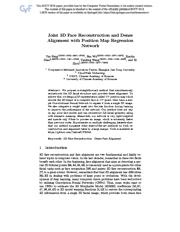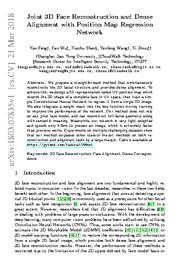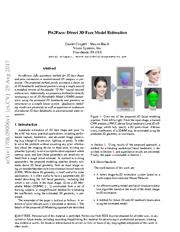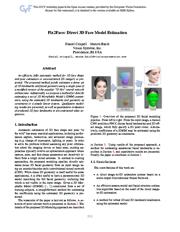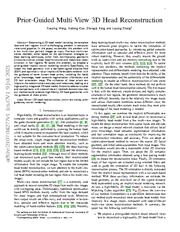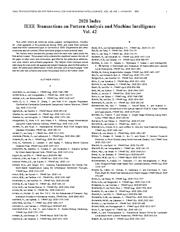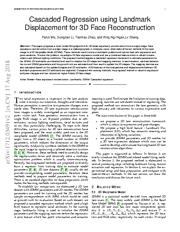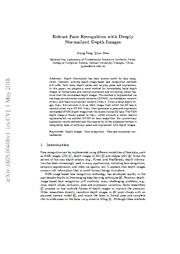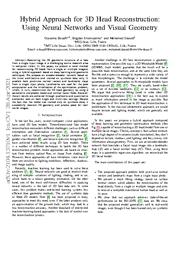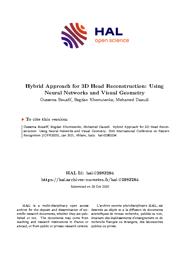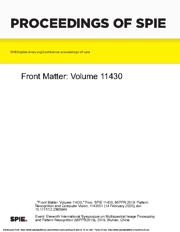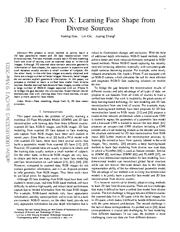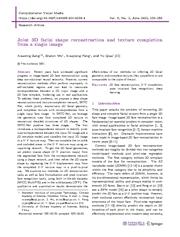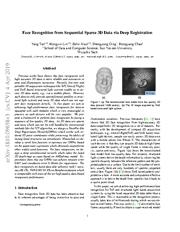A copy of this work was available on the public web and has been preserved in the Wayback Machine. The capture dates from 2019; you can also visit the original URL.
The file type is application/pdf.
Filters
Joint 3D Face Reconstruction and Dense Alignment with Position Map Regression Network
[chapter]
2018
Lecture Notes in Computer Science
We propose a straightforward method that simultaneously reconstructs the 3D facial structure and provides dense alignment. ...
To achieve this, we design a 2D representation called UV position map which records the 3D shape of a complete face in UV space, then train a simple Convolutional Neural Network to regress it from a single ...
However, discretization limits the resolution of point cloud, and most part of the network output correspond to non-surface points which are of less usage. ...
doi:10.1007/978-3-030-01264-9_33
fatcat:ebcqdhdj3jhxph2stxznvcj5ke
Joint 3D Face Reconstruction and Dense Alignment with Position Map Regression Network
[article]
2018
arXiv
pre-print
We propose a straightforward method that simultaneously reconstructs the 3D facial structure and provides dense alignment. ...
To achieve this, we design a 2D representation called UV position map which records the 3D shape of a complete face in UV space, then train a simple Convolutional Neural Network to regress it from a single ...
We also thank Iacopo Masi for his patience in helping me acquire Florence 3D Face dataset. This work was supported by CloudWalk Technology. ...
arXiv:1803.07835v1
fatcat:sybi46n4wzamvgj72j3u23gpbe
Pix2face: Direct 3D Face Model Estimation
[article]
2017
arXiv
pre-print
The proposed method jointly estimates a dense set of 3D landmarks and facial geometry using a single pass of a modified version of the popular "U-Net" neural network architecture. ...
Additionally, we propose a method for directly estimating a set of 3D Morphable Model (3DMM) parameters, using the estimated 3D landmarks and geometry as constraints in a simple linear system. ...
Acknowledgement This research is based upon work supported by the Office of the Director of National Intelligence (ODNI), Intelligence Advanced Research Projects Activity (IARPA) under contract number ...
arXiv:1708.09006v1
fatcat:mkiy7zes4ve33epcqmudzu3gxm
Pix2Face: Direct 3D Face Model Estimation
2017
2017 IEEE International Conference on Computer Vision Workshops (ICCVW)
The proposed method jointly estimates a dense set of 3D landmarks and facial geometry using a single pass of a modified version of the popular "U-Net" neural network architecture. ...
Additionally, we propose a method for directly estimating a set of 3D Morphable Model (3DMM) parameters, using the estimated 3D landmarks and geometry as constraints in a simple linear system. ...
Acknowledgement This research is based upon work supported by the Office of the Director of National Intelligence (ODNI), Intelligence Advanced Research Projects Activity (IARPA) under contract number ...
doi:10.1109/iccvw.2017.295
dblp:conf/iccvw/CrispellB17
fatcat:aaupabopqbdhreu5bmkje27wq4
3D Facial Geometry Recovery from a Depth View with Attention Guided Generative Adversarial Network
[article]
2020
arXiv
pre-print
In contrast to existing work which normally requires two or more depth views to recover a full 3D facial geometry, the proposed AGGAN is able to generate a dense 3D voxel grid of the face from a single ...
Multiple loss functions, which enforce the 3D facial geometry consistency, together with a prior distribution of facial surface points in voxel space are incorporated to guide the training process. ...
Generally, non-rigid registration methods first build dense point correspondences between the projected 3D point cloud and a template 3D facial mesh, and then conforms the template mesh to the point cloud ...
arXiv:2009.00938v1
fatcat:o7h7m4lo5zhdxirftsasq6izki
Prior-Guided Multi-View 3D Head Reconstruction
[article]
2021
arXiv
pre-print
To tackle this problem, we propose a prior-guided implicit neural rendering network. ...
Extensive ablation studies and comparisons with state-of-the-art methods demonstrate that our method could produce high-fidelity 3D head geometries with the guidance of these priors. ...
and dense point cloud fusion. ...
arXiv:2107.04277v1
fatcat:fxiuaf2icvac5gety2hfvqlbuy
2020 Index IEEE Transactions on Pattern Analysis and Machine Intelligence Vol. 42
2021
IEEE Transactions on Pattern Analysis and Machine Intelligence
., +, TPAMI Feb.
2020 494-501
Generic Primitive Detection in Point Clouds Using Novel Minimal Quadric
Fits. ...
., +, TPAMI Aug. 2020 1823-1841
Generic Primitive Detection in Point Clouds Using Novel Minimal Quadric
Fits. ...
., +, TPAMI Feb. 2020 261-275 Clouds of Oriented Gradients for 3D Detection of Objects, Surfaces, and Indoor Scene Layouts. ...
doi:10.1109/tpami.2020.3036557
fatcat:3j6s2l53x5eqxnlsptsgbjeebe
3D Facial Expression Reconstruction using Cascaded Regression
[article]
2018
arXiv
pre-print
This paper proposes a novel model fitting algorithm for 3D facial expression reconstruction from a single image. ...
Most state-of-the-art methods fit the input image to a 3D Morphable Model (3DMM). These methods need to solve a stochastic problem and cannot deal with expression and pose variations. ...
Then, a dense fitting was performed which fitted the 3DMM to both the landmarks and the 3D point cloud. ...
arXiv:1712.03491v2
fatcat:3l2mmqxiyvdxpaumxgzz253a74
Robust Face Recognition with Deeply Normalized Depth Images
[article]
2018
arXiv
pre-print
The method is implemented via two deep convolutional neural networks (DCNN), normalization network (Net_N) and feature extraction network (Net_F). ...
Given a facial depth image, Net_N first converts it to an HHA image, from which the 3D face is reconstructed via a DCNN. ...
Other researchers directly transform depth images to 3D point clouds with an assumed camera model [5] , and rotate the faces to frontal pose and complete the invisible areas on the faces via symmetric ...
arXiv:1805.00406v1
fatcat:q2xjeejvsvghhp364w5r4hhb7q
Hybrid Approach for 3D Head Reconstruction: Using Neural Networks and Visual Geometry
[article]
2021
arXiv
pre-print
Recovering the 3D geometric structure of a face from a single input image is a challenging active research area in computer vision. ...
Landmarks are used for the pose computation and the initialization of the optimization problem, which, in turn, reconstructs the 3D head geometry by using a parametric morphable model and normal vector ...
This modelfree approach produced curves that are combined together to obtain a more accurate combined 3D point cloud. ...
arXiv:2104.13710v1
fatcat:wg3dvn2lwnd47hh6idbj5eio6y
Hybrid Approach for 3D Head Reconstruction: Using Neural Networks and Visual Geometry
2021
2020 25th International Conference on Pattern Recognition (ICPR)
Recovering the 3D geometric structure of a face from a single input image is a challenging active research area in computer vision. ...
Landmarks are used for the pose computation and the initialization of the optimization problem, which, in turn, reconstructs the 3D head geometry by using a parametric morphable model and normal vector ...
This modelfree approach produced curves that are combined together to obtain a more accurate combined 3D point cloud. ...
doi:10.1109/icpr48806.2021.9412782
fatcat:qdbv6wi7djav5eyo5lnlricxou
Front Matter: Volume 11430
2020
MIPPR 2019: Pattern Recognition and Computer Vision
SPIE uses a seven-digit CID article numbering system structured as follows: § The first five digits correspond to the SPIE volume number. § The last two digits indicate publication order within the volume ...
Publication of record for individual papers is online in the SPIE Digital Library. SPIEDigitalLibrary.org Paper Numbering: Proceedings of SPIE follow an e-First publication model. ...
in 3D point cloud [11430-85]
11430 1Q
Increment adaptive correlation filter for visual tracking [11430-90]
11430 1R
Facial morphe via domain translation and FM 2 RLS [11430-91]
11430 1S
TLCS-Anchor ...
doi:10.1117/12.2565844
fatcat:kapfwn4xajdt3jzin3mks33oam
3D Face From X: Learning Face Shape from Diverse Sources
[article]
2021
arXiv
pre-print
On the other hand, in-the-wild face images are easily obtained and there are a large number of facial images. However, facial images do not contain explicit geometric information. ...
Previous methods usually learn 3D face modeling from one kind of source, such as scanned data or in-the-wild images. ...
With the powerfulness of convolution neural networks, various deep learning-based methods have been developed for 3D face reconstruction, face alignment, face recognition and dense facial correspondences ...
arXiv:1808.05323v3
fatcat:2ivplklvcnfkradpqjucqqf5j4
Joint 3D facial shape reconstruction and texture completion from a single image
2021
Computational Visual Media
To get the 3D facial geometries, we predict coarse shape (U-V position maps) from the segmented face from the correspondence network using a shape network, and then refine the 3D coarse shape by regressing ...
AbstractRecent years have witnessed significant progress in image-based 3D face reconstruction using deep convolutional neural networks. ...
We would like to thank Yu Deng et al. for their Deep 3D Face work in 3D face analysis, whose contribution to this field permitted our further study. ...
doi:10.1007/s41095-021-0238-4
fatcat:trtdm3c7ljd3pb7lvxlmxq6dhu
Face Recognition from Sequential Sparse 3D Data via Deep Registration
[article]
2019
arXiv
pre-print
As 3D data are sparse and noisy which can not be well handled by conventional methods like the ICP algorithm, we design a PointNet-like Deep Registration Network(DRNet) which works with ordered 3D point ...
Recently, low-cost and portable 3D acquisition techniques like ToF(Time of Flight) and DoE based structured light systems enable us to access 3D data easily, e.g., via a mobile phone. ...
To the best of our knowledge, we are the first to align 3D facial point clouds via a neural network. • We study how the 3D data quality impacts face recognition and demonstrate the possibility of achieving ...
arXiv:1810.09658v3
fatcat:6265ozvm45co3nmlhen3xctisa
« Previous
Showing results 1 — 15 out of 1,018 results

